Leadership, Management, and Operations: Starbucks Analysis Report
VerifiedAdded on 2022/12/27
|15
|4019
|22
Report
AI Summary
This report delves into the crucial roles of leaders and managers within organizations, examining their functions in diverse situations such as strategic planning, change management, and product launches, using the Starbucks case study as a practical example. It explores various leadership theories, including situational, contingency, and system leadership, evaluating their strengths and weaknesses. Furthermore, the report investigates key approaches to operations management like Six Sigma, Total Quality Management, and Just-in-Time, highlighting the roles of leaders and managers in implementing these strategies. The analysis provides insights into how effective leadership and management contribute to organizational success and growth, particularly within the context of a global brand like Starbucks. The report focuses on the different approaches to leadership that can be adopted by managers to achieve organizational goals and objectives. It also discusses the importance of operations management in the success of an organization and the role that leaders and managers play in it.
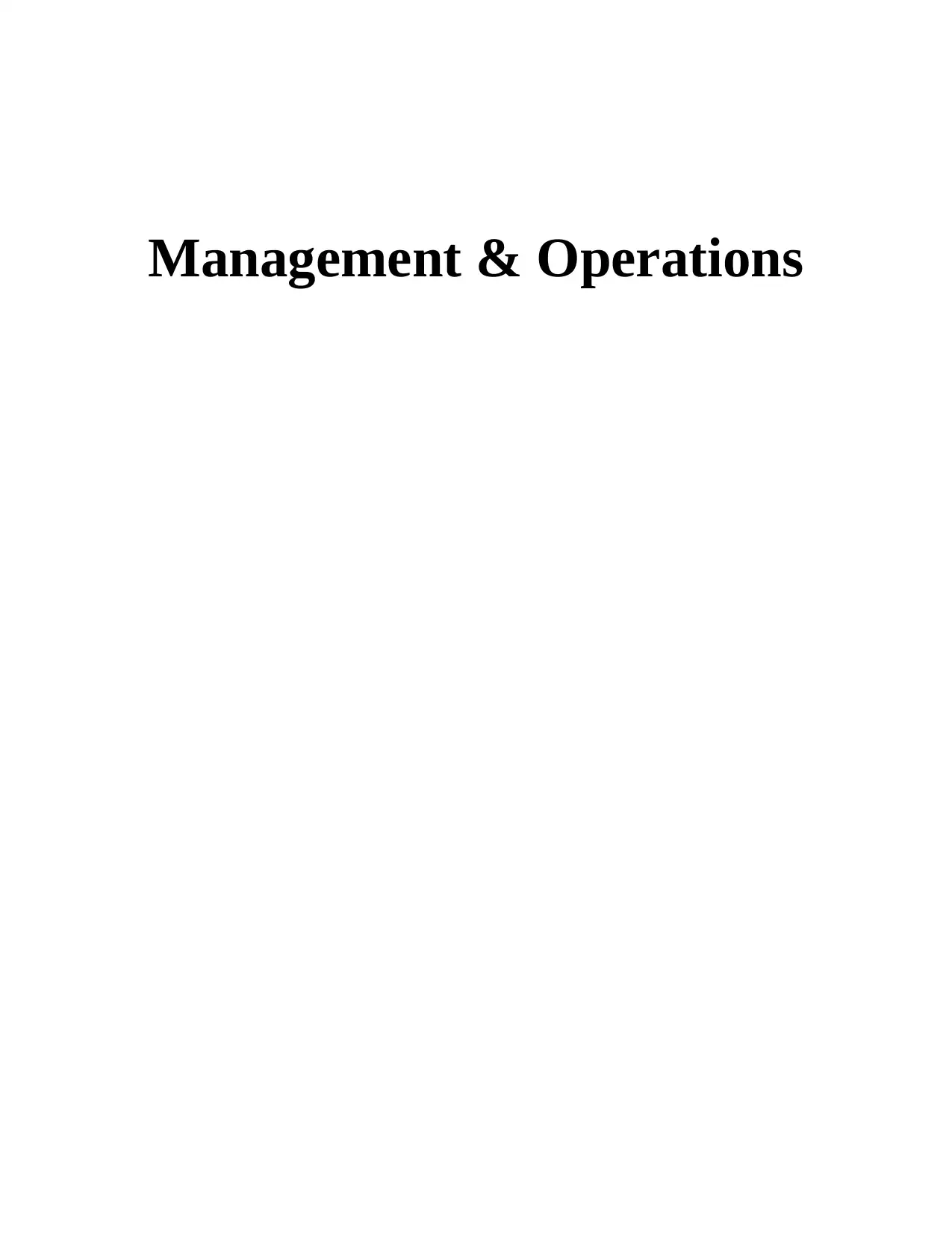
Management & Operations
Paraphrase This Document
Need a fresh take? Get an instant paraphrase of this document with our AI Paraphraser
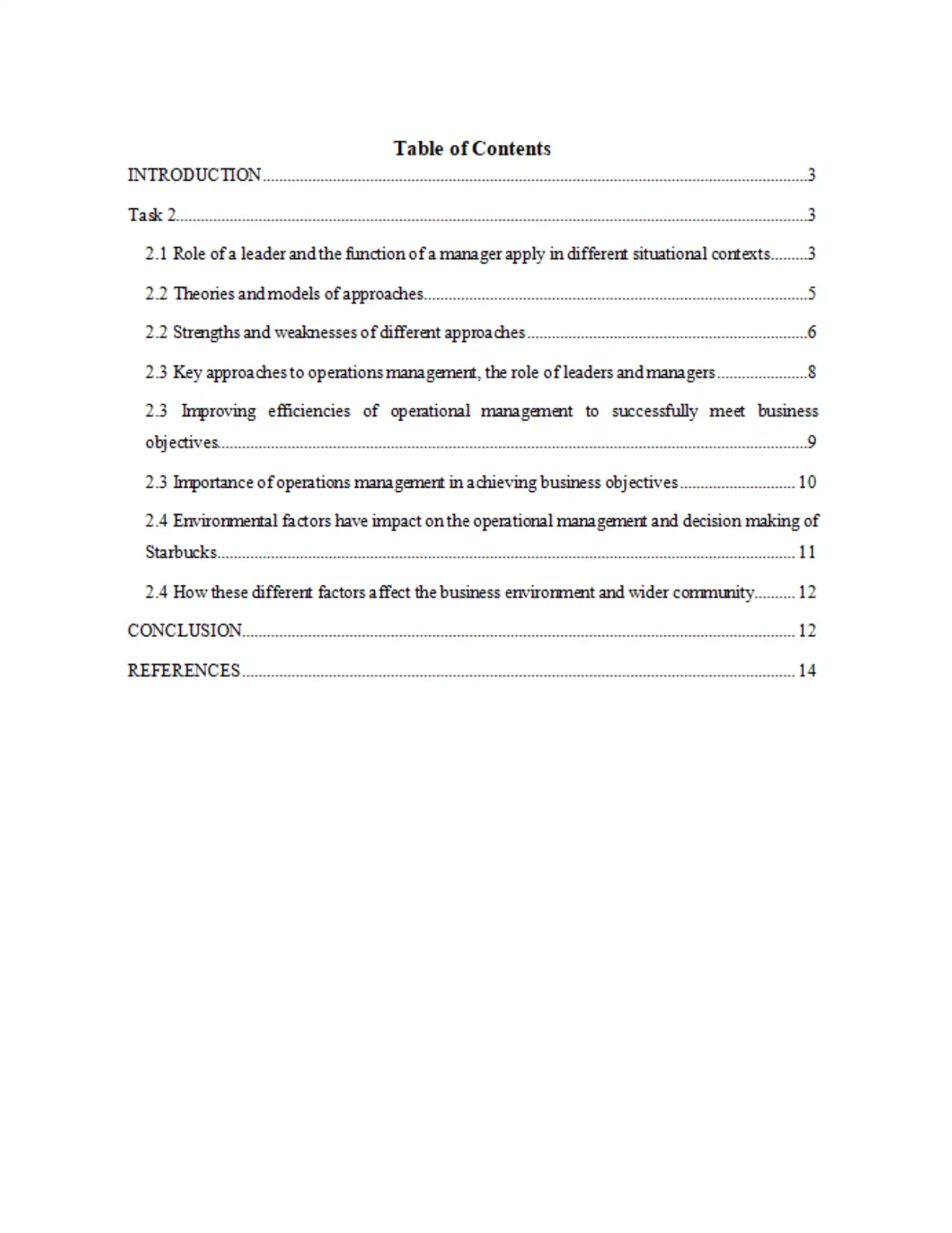
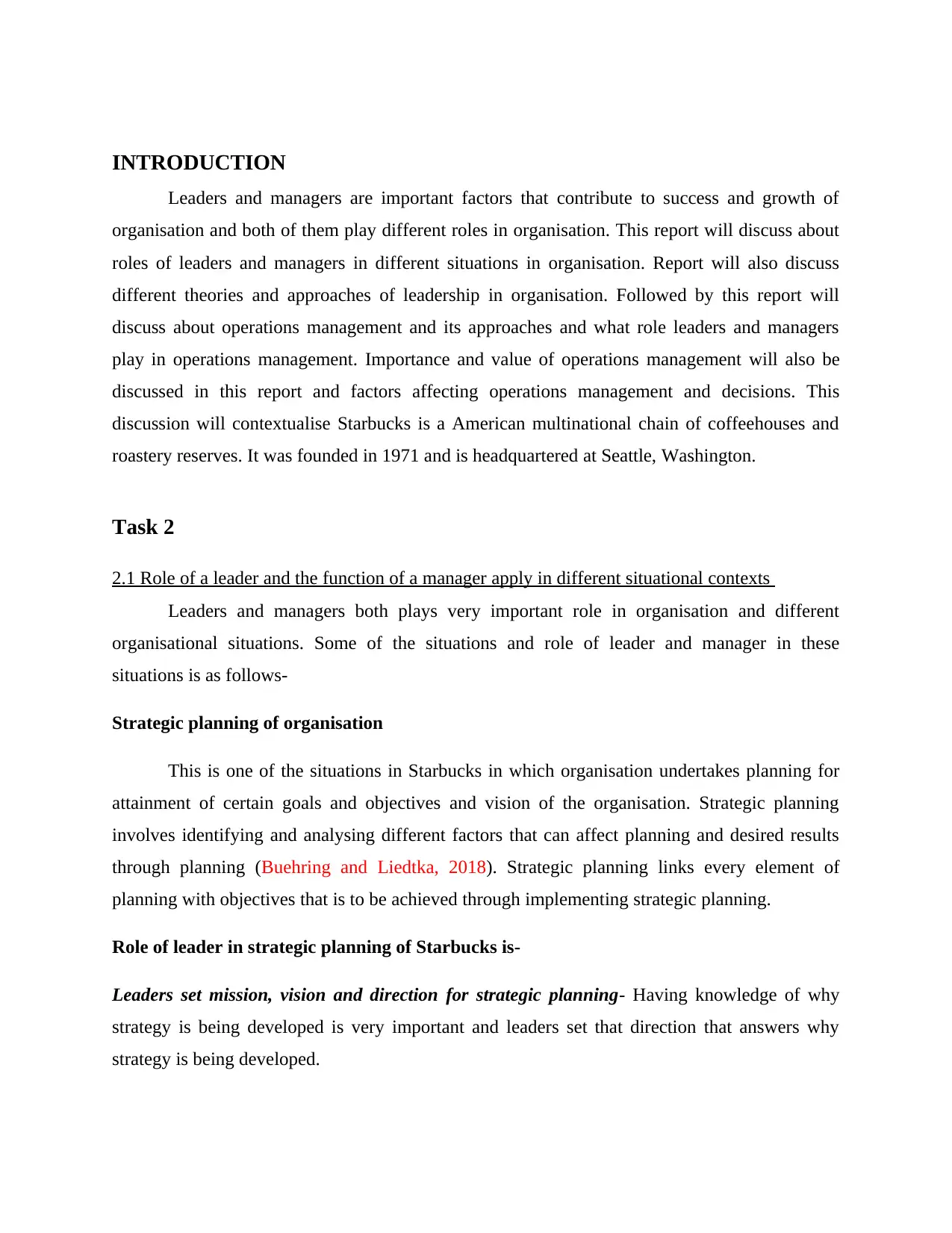
INTRODUCTION
Leaders and managers are important factors that contribute to success and growth of
organisation and both of them play different roles in organisation. This report will discuss about
roles of leaders and managers in different situations in organisation. Report will also discuss
different theories and approaches of leadership in organisation. Followed by this report will
discuss about operations management and its approaches and what role leaders and managers
play in operations management. Importance and value of operations management will also be
discussed in this report and factors affecting operations management and decisions. This
discussion will contextualise Starbucks is a American multinational chain of coffeehouses and
roastery reserves. It was founded in 1971 and is headquartered at Seattle, Washington.
Task 2
2.1 Role of a leader and the function of a manager apply in different situational contexts
Leaders and managers both plays very important role in organisation and different
organisational situations. Some of the situations and role of leader and manager in these
situations is as follows-
Strategic planning of organisation
This is one of the situations in Starbucks in which organisation undertakes planning for
attainment of certain goals and objectives and vision of the organisation. Strategic planning
involves identifying and analysing different factors that can affect planning and desired results
through planning (Buehring and Liedtka, 2018). Strategic planning links every element of
planning with objectives that is to be achieved through implementing strategic planning.
Role of leader in strategic planning of Starbucks is-
Leaders set mission, vision and direction for strategic planning- Having knowledge of why
strategy is being developed is very important and leaders set that direction that answers why
strategy is being developed.
Leaders and managers are important factors that contribute to success and growth of
organisation and both of them play different roles in organisation. This report will discuss about
roles of leaders and managers in different situations in organisation. Report will also discuss
different theories and approaches of leadership in organisation. Followed by this report will
discuss about operations management and its approaches and what role leaders and managers
play in operations management. Importance and value of operations management will also be
discussed in this report and factors affecting operations management and decisions. This
discussion will contextualise Starbucks is a American multinational chain of coffeehouses and
roastery reserves. It was founded in 1971 and is headquartered at Seattle, Washington.
Task 2
2.1 Role of a leader and the function of a manager apply in different situational contexts
Leaders and managers both plays very important role in organisation and different
organisational situations. Some of the situations and role of leader and manager in these
situations is as follows-
Strategic planning of organisation
This is one of the situations in Starbucks in which organisation undertakes planning for
attainment of certain goals and objectives and vision of the organisation. Strategic planning
involves identifying and analysing different factors that can affect planning and desired results
through planning (Buehring and Liedtka, 2018). Strategic planning links every element of
planning with objectives that is to be achieved through implementing strategic planning.
Role of leader in strategic planning of Starbucks is-
Leaders set mission, vision and direction for strategic planning- Having knowledge of why
strategy is being developed is very important and leaders set that direction that answers why
strategy is being developed.
⊘ This is a preview!⊘
Do you want full access?
Subscribe today to unlock all pages.

Trusted by 1+ million students worldwide
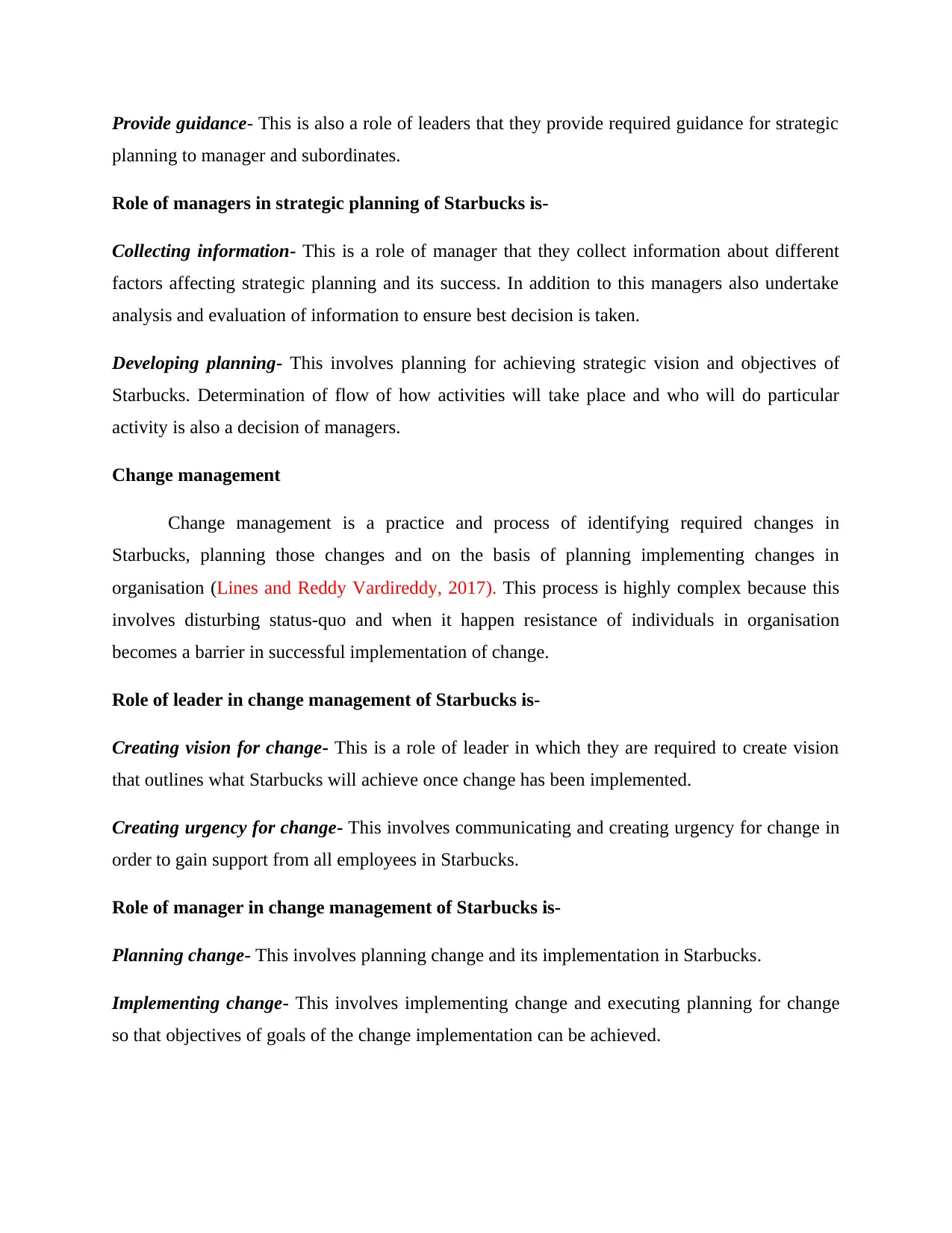
Provide guidance- This is also a role of leaders that they provide required guidance for strategic
planning to manager and subordinates.
Role of managers in strategic planning of Starbucks is-
Collecting information- This is a role of manager that they collect information about different
factors affecting strategic planning and its success. In addition to this managers also undertake
analysis and evaluation of information to ensure best decision is taken.
Developing planning- This involves planning for achieving strategic vision and objectives of
Starbucks. Determination of flow of how activities will take place and who will do particular
activity is also a decision of managers.
Change management
Change management is a practice and process of identifying required changes in
Starbucks, planning those changes and on the basis of planning implementing changes in
organisation (Lines and Reddy Vardireddy, 2017). This process is highly complex because this
involves disturbing status-quo and when it happen resistance of individuals in organisation
becomes a barrier in successful implementation of change.
Role of leader in change management of Starbucks is-
Creating vision for change- This is a role of leader in which they are required to create vision
that outlines what Starbucks will achieve once change has been implemented.
Creating urgency for change- This involves communicating and creating urgency for change in
order to gain support from all employees in Starbucks.
Role of manager in change management of Starbucks is-
Planning change- This involves planning change and its implementation in Starbucks.
Implementing change- This involves implementing change and executing planning for change
so that objectives of goals of the change implementation can be achieved.
planning to manager and subordinates.
Role of managers in strategic planning of Starbucks is-
Collecting information- This is a role of manager that they collect information about different
factors affecting strategic planning and its success. In addition to this managers also undertake
analysis and evaluation of information to ensure best decision is taken.
Developing planning- This involves planning for achieving strategic vision and objectives of
Starbucks. Determination of flow of how activities will take place and who will do particular
activity is also a decision of managers.
Change management
Change management is a practice and process of identifying required changes in
Starbucks, planning those changes and on the basis of planning implementing changes in
organisation (Lines and Reddy Vardireddy, 2017). This process is highly complex because this
involves disturbing status-quo and when it happen resistance of individuals in organisation
becomes a barrier in successful implementation of change.
Role of leader in change management of Starbucks is-
Creating vision for change- This is a role of leader in which they are required to create vision
that outlines what Starbucks will achieve once change has been implemented.
Creating urgency for change- This involves communicating and creating urgency for change in
order to gain support from all employees in Starbucks.
Role of manager in change management of Starbucks is-
Planning change- This involves planning change and its implementation in Starbucks.
Implementing change- This involves implementing change and executing planning for change
so that objectives of goals of the change implementation can be achieved.
Paraphrase This Document
Need a fresh take? Get an instant paraphrase of this document with our AI Paraphraser
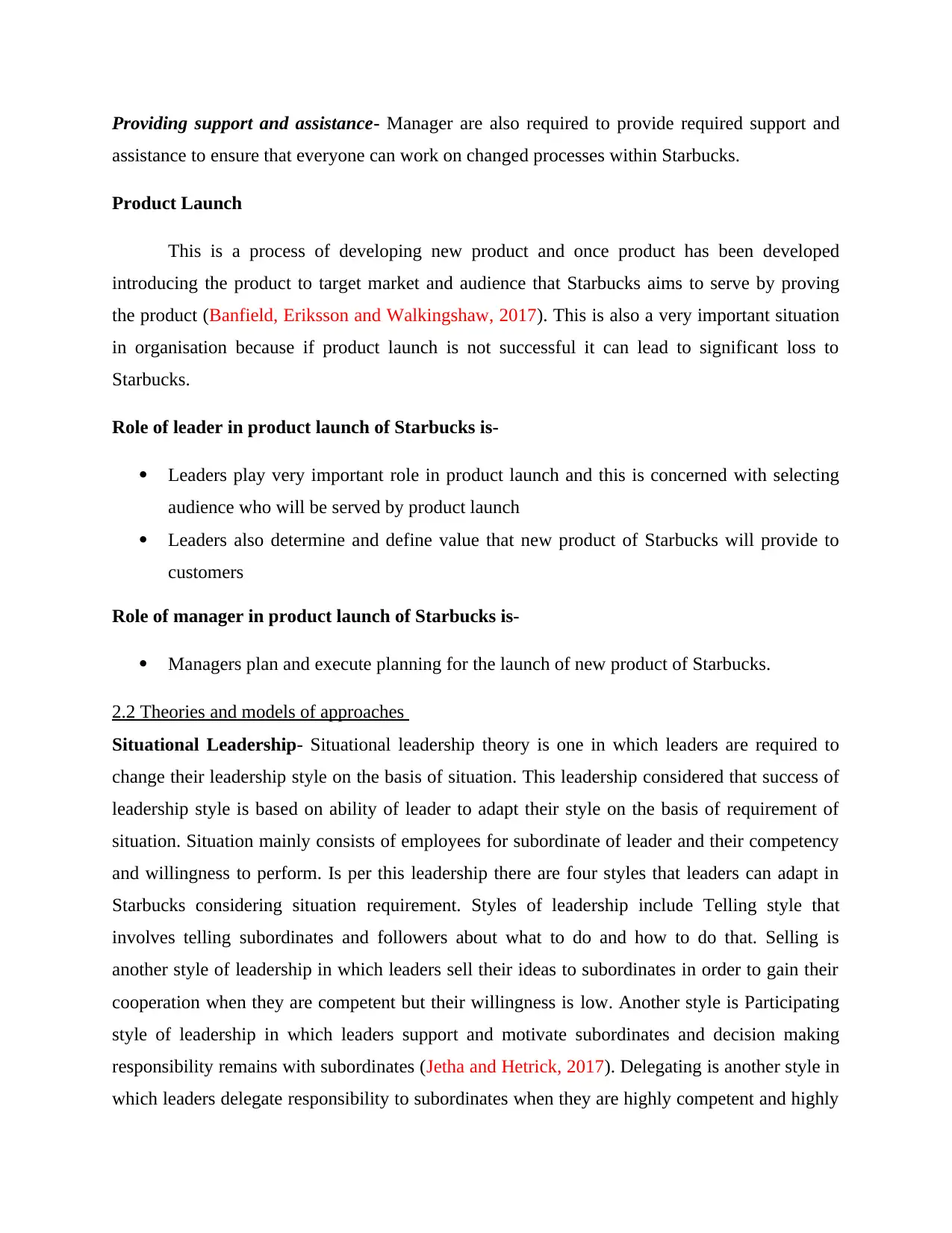
Providing support and assistance- Manager are also required to provide required support and
assistance to ensure that everyone can work on changed processes within Starbucks.
Product Launch
This is a process of developing new product and once product has been developed
introducing the product to target market and audience that Starbucks aims to serve by proving
the product (Banfield, Eriksson and Walkingshaw, 2017). This is also a very important situation
in organisation because if product launch is not successful it can lead to significant loss to
Starbucks.
Role of leader in product launch of Starbucks is-
Leaders play very important role in product launch and this is concerned with selecting
audience who will be served by product launch
Leaders also determine and define value that new product of Starbucks will provide to
customers
Role of manager in product launch of Starbucks is-
Managers plan and execute planning for the launch of new product of Starbucks.
2.2 Theories and models of approaches
Situational Leadership- Situational leadership theory is one in which leaders are required to
change their leadership style on the basis of situation. This leadership considered that success of
leadership style is based on ability of leader to adapt their style on the basis of requirement of
situation. Situation mainly consists of employees for subordinate of leader and their competency
and willingness to perform. Is per this leadership there are four styles that leaders can adapt in
Starbucks considering situation requirement. Styles of leadership include Telling style that
involves telling subordinates and followers about what to do and how to do that. Selling is
another style of leadership in which leaders sell their ideas to subordinates in order to gain their
cooperation when they are competent but their willingness is low. Another style is Participating
style of leadership in which leaders support and motivate subordinates and decision making
responsibility remains with subordinates (Jetha and Hetrick, 2017). Delegating is another style in
which leaders delegate responsibility to subordinates when they are highly competent and highly
assistance to ensure that everyone can work on changed processes within Starbucks.
Product Launch
This is a process of developing new product and once product has been developed
introducing the product to target market and audience that Starbucks aims to serve by proving
the product (Banfield, Eriksson and Walkingshaw, 2017). This is also a very important situation
in organisation because if product launch is not successful it can lead to significant loss to
Starbucks.
Role of leader in product launch of Starbucks is-
Leaders play very important role in product launch and this is concerned with selecting
audience who will be served by product launch
Leaders also determine and define value that new product of Starbucks will provide to
customers
Role of manager in product launch of Starbucks is-
Managers plan and execute planning for the launch of new product of Starbucks.
2.2 Theories and models of approaches
Situational Leadership- Situational leadership theory is one in which leaders are required to
change their leadership style on the basis of situation. This leadership considered that success of
leadership style is based on ability of leader to adapt their style on the basis of requirement of
situation. Situation mainly consists of employees for subordinate of leader and their competency
and willingness to perform. Is per this leadership there are four styles that leaders can adapt in
Starbucks considering situation requirement. Styles of leadership include Telling style that
involves telling subordinates and followers about what to do and how to do that. Selling is
another style of leadership in which leaders sell their ideas to subordinates in order to gain their
cooperation when they are competent but their willingness is low. Another style is Participating
style of leadership in which leaders support and motivate subordinates and decision making
responsibility remains with subordinates (Jetha and Hetrick, 2017). Delegating is another style in
which leaders delegate responsibility to subordinates when they are highly competent and highly
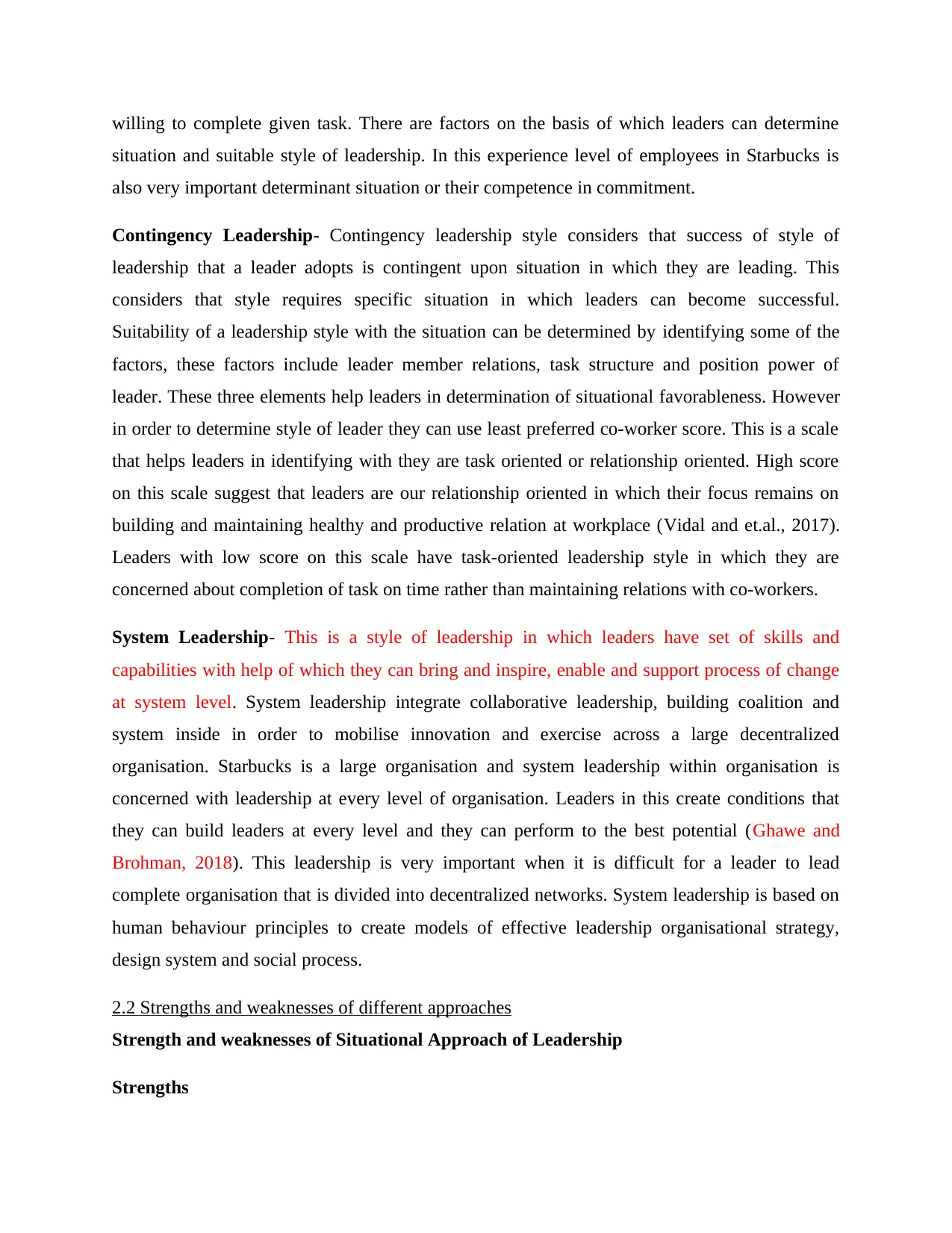
willing to complete given task. There are factors on the basis of which leaders can determine
situation and suitable style of leadership. In this experience level of employees in Starbucks is
also very important determinant situation or their competence in commitment.
Contingency Leadership- Contingency leadership style considers that success of style of
leadership that a leader adopts is contingent upon situation in which they are leading. This
considers that style requires specific situation in which leaders can become successful.
Suitability of a leadership style with the situation can be determined by identifying some of the
factors, these factors include leader member relations, task structure and position power of
leader. These three elements help leaders in determination of situational favorableness. However
in order to determine style of leader they can use least preferred co-worker score. This is a scale
that helps leaders in identifying with they are task oriented or relationship oriented. High score
on this scale suggest that leaders are our relationship oriented in which their focus remains on
building and maintaining healthy and productive relation at workplace (Vidal and et.al., 2017).
Leaders with low score on this scale have task-oriented leadership style in which they are
concerned about completion of task on time rather than maintaining relations with co-workers.
System Leadership- This is a style of leadership in which leaders have set of skills and
capabilities with help of which they can bring and inspire, enable and support process of change
at system level. System leadership integrate collaborative leadership, building coalition and
system inside in order to mobilise innovation and exercise across a large decentralized
organisation. Starbucks is a large organisation and system leadership within organisation is
concerned with leadership at every level of organisation. Leaders in this create conditions that
they can build leaders at every level and they can perform to the best potential (Ghawe and
Brohman, 2018). This leadership is very important when it is difficult for a leader to lead
complete organisation that is divided into decentralized networks. System leadership is based on
human behaviour principles to create models of effective leadership organisational strategy,
design system and social process.
2.2 Strengths and weaknesses of different approaches
Strength and weaknesses of Situational Approach of Leadership
Strengths
situation and suitable style of leadership. In this experience level of employees in Starbucks is
also very important determinant situation or their competence in commitment.
Contingency Leadership- Contingency leadership style considers that success of style of
leadership that a leader adopts is contingent upon situation in which they are leading. This
considers that style requires specific situation in which leaders can become successful.
Suitability of a leadership style with the situation can be determined by identifying some of the
factors, these factors include leader member relations, task structure and position power of
leader. These three elements help leaders in determination of situational favorableness. However
in order to determine style of leader they can use least preferred co-worker score. This is a scale
that helps leaders in identifying with they are task oriented or relationship oriented. High score
on this scale suggest that leaders are our relationship oriented in which their focus remains on
building and maintaining healthy and productive relation at workplace (Vidal and et.al., 2017).
Leaders with low score on this scale have task-oriented leadership style in which they are
concerned about completion of task on time rather than maintaining relations with co-workers.
System Leadership- This is a style of leadership in which leaders have set of skills and
capabilities with help of which they can bring and inspire, enable and support process of change
at system level. System leadership integrate collaborative leadership, building coalition and
system inside in order to mobilise innovation and exercise across a large decentralized
organisation. Starbucks is a large organisation and system leadership within organisation is
concerned with leadership at every level of organisation. Leaders in this create conditions that
they can build leaders at every level and they can perform to the best potential (Ghawe and
Brohman, 2018). This leadership is very important when it is difficult for a leader to lead
complete organisation that is divided into decentralized networks. System leadership is based on
human behaviour principles to create models of effective leadership organisational strategy,
design system and social process.
2.2 Strengths and weaknesses of different approaches
Strength and weaknesses of Situational Approach of Leadership
Strengths
⊘ This is a preview!⊘
Do you want full access?
Subscribe today to unlock all pages.

Trusted by 1+ million students worldwide
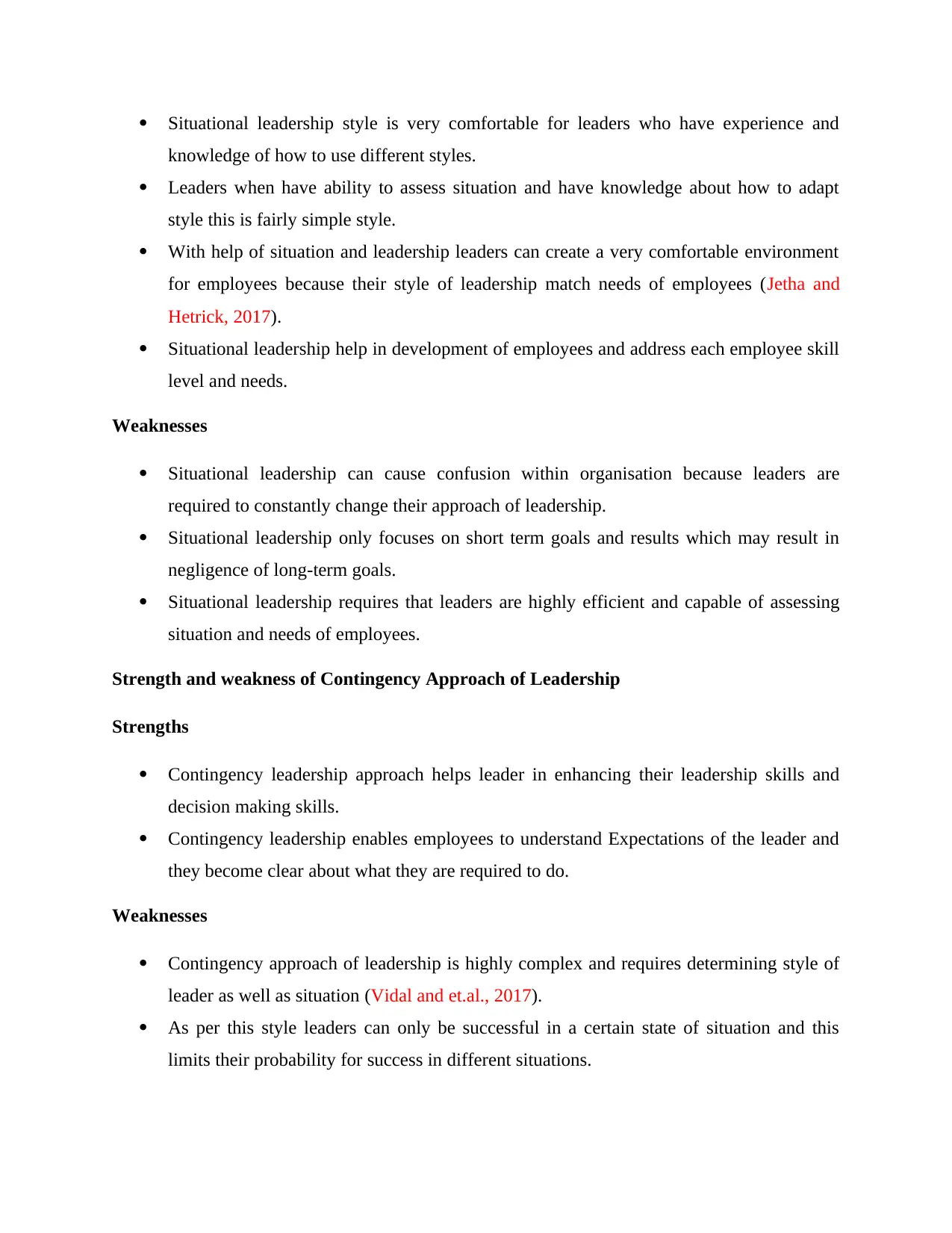
Situational leadership style is very comfortable for leaders who have experience and
knowledge of how to use different styles.
Leaders when have ability to assess situation and have knowledge about how to adapt
style this is fairly simple style.
With help of situation and leadership leaders can create a very comfortable environment
for employees because their style of leadership match needs of employees (Jetha and
Hetrick, 2017).
Situational leadership help in development of employees and address each employee skill
level and needs.
Weaknesses
Situational leadership can cause confusion within organisation because leaders are
required to constantly change their approach of leadership.
Situational leadership only focuses on short term goals and results which may result in
negligence of long-term goals.
Situational leadership requires that leaders are highly efficient and capable of assessing
situation and needs of employees.
Strength and weakness of Contingency Approach of Leadership
Strengths
Contingency leadership approach helps leader in enhancing their leadership skills and
decision making skills.
Contingency leadership enables employees to understand Expectations of the leader and
they become clear about what they are required to do.
Weaknesses
Contingency approach of leadership is highly complex and requires determining style of
leader as well as situation (Vidal and et.al., 2017).
As per this style leaders can only be successful in a certain state of situation and this
limits their probability for success in different situations.
knowledge of how to use different styles.
Leaders when have ability to assess situation and have knowledge about how to adapt
style this is fairly simple style.
With help of situation and leadership leaders can create a very comfortable environment
for employees because their style of leadership match needs of employees (Jetha and
Hetrick, 2017).
Situational leadership help in development of employees and address each employee skill
level and needs.
Weaknesses
Situational leadership can cause confusion within organisation because leaders are
required to constantly change their approach of leadership.
Situational leadership only focuses on short term goals and results which may result in
negligence of long-term goals.
Situational leadership requires that leaders are highly efficient and capable of assessing
situation and needs of employees.
Strength and weakness of Contingency Approach of Leadership
Strengths
Contingency leadership approach helps leader in enhancing their leadership skills and
decision making skills.
Contingency leadership enables employees to understand Expectations of the leader and
they become clear about what they are required to do.
Weaknesses
Contingency approach of leadership is highly complex and requires determining style of
leader as well as situation (Vidal and et.al., 2017).
As per this style leaders can only be successful in a certain state of situation and this
limits their probability for success in different situations.
Paraphrase This Document
Need a fresh take? Get an instant paraphrase of this document with our AI Paraphraser
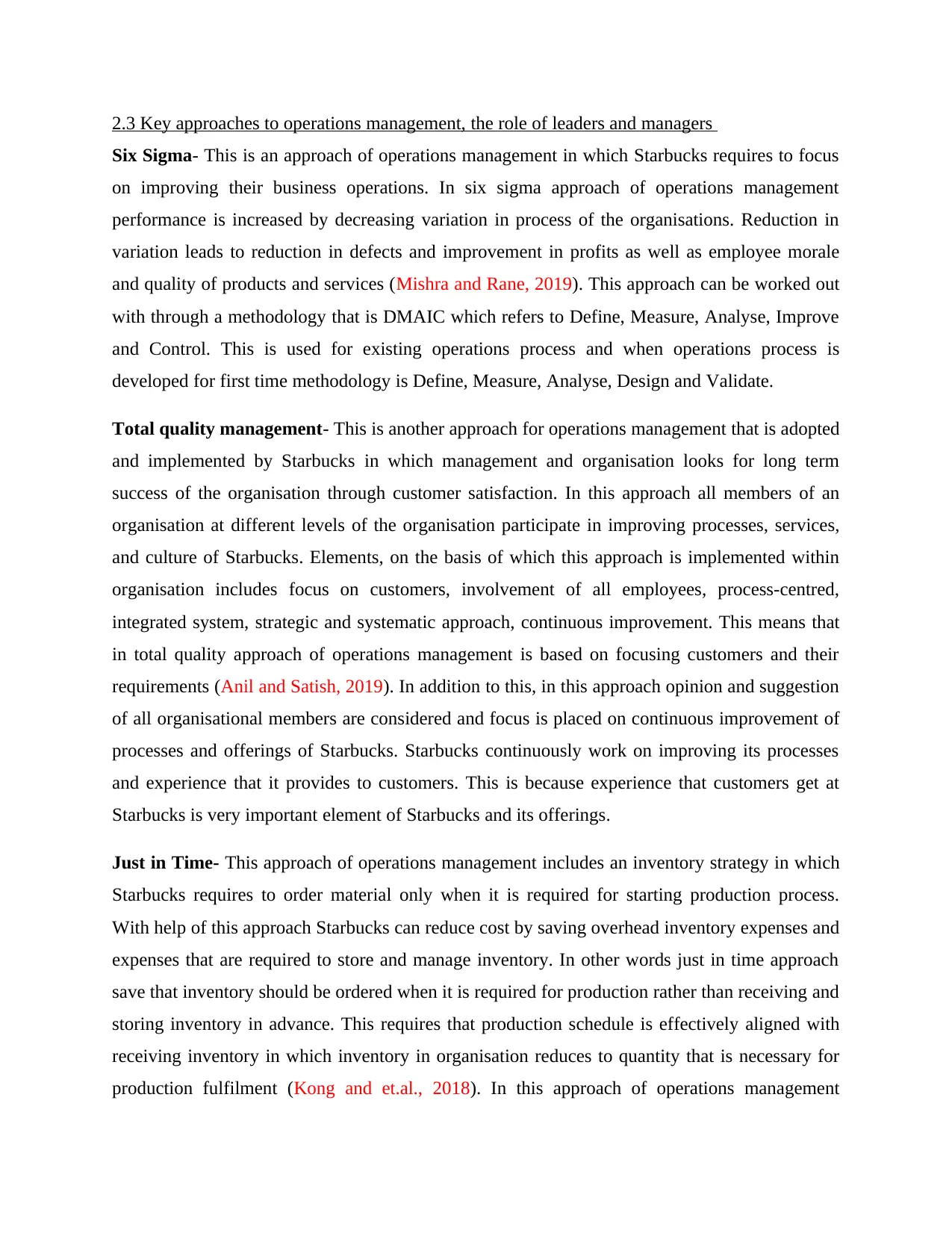
2.3 Key approaches to operations management, the role of leaders and managers
Six Sigma- This is an approach of operations management in which Starbucks requires to focus
on improving their business operations. In six sigma approach of operations management
performance is increased by decreasing variation in process of the organisations. Reduction in
variation leads to reduction in defects and improvement in profits as well as employee morale
and quality of products and services (Mishra and Rane, 2019). This approach can be worked out
with through a methodology that is DMAIC which refers to Define, Measure, Analyse, Improve
and Control. This is used for existing operations process and when operations process is
developed for first time methodology is Define, Measure, Analyse, Design and Validate.
Total quality management- This is another approach for operations management that is adopted
and implemented by Starbucks in which management and organisation looks for long term
success of the organisation through customer satisfaction. In this approach all members of an
organisation at different levels of the organisation participate in improving processes, services,
and culture of Starbucks. Elements, on the basis of which this approach is implemented within
organisation includes focus on customers, involvement of all employees, process-centred,
integrated system, strategic and systematic approach, continuous improvement. This means that
in total quality approach of operations management is based on focusing customers and their
requirements (Anil and Satish, 2019). In addition to this, in this approach opinion and suggestion
of all organisational members are considered and focus is placed on continuous improvement of
processes and offerings of Starbucks. Starbucks continuously work on improving its processes
and experience that it provides to customers. This is because experience that customers get at
Starbucks is very important element of Starbucks and its offerings.
Just in Time- This approach of operations management includes an inventory strategy in which
Starbucks requires to order material only when it is required for starting production process.
With help of this approach Starbucks can reduce cost by saving overhead inventory expenses and
expenses that are required to store and manage inventory. In other words just in time approach
save that inventory should be ordered when it is required for production rather than receiving and
storing inventory in advance. This requires that production schedule is effectively aligned with
receiving inventory in which inventory in organisation reduces to quantity that is necessary for
production fulfilment (Kong and et.al., 2018). In this approach of operations management
Six Sigma- This is an approach of operations management in which Starbucks requires to focus
on improving their business operations. In six sigma approach of operations management
performance is increased by decreasing variation in process of the organisations. Reduction in
variation leads to reduction in defects and improvement in profits as well as employee morale
and quality of products and services (Mishra and Rane, 2019). This approach can be worked out
with through a methodology that is DMAIC which refers to Define, Measure, Analyse, Improve
and Control. This is used for existing operations process and when operations process is
developed for first time methodology is Define, Measure, Analyse, Design and Validate.
Total quality management- This is another approach for operations management that is adopted
and implemented by Starbucks in which management and organisation looks for long term
success of the organisation through customer satisfaction. In this approach all members of an
organisation at different levels of the organisation participate in improving processes, services,
and culture of Starbucks. Elements, on the basis of which this approach is implemented within
organisation includes focus on customers, involvement of all employees, process-centred,
integrated system, strategic and systematic approach, continuous improvement. This means that
in total quality approach of operations management is based on focusing customers and their
requirements (Anil and Satish, 2019). In addition to this, in this approach opinion and suggestion
of all organisational members are considered and focus is placed on continuous improvement of
processes and offerings of Starbucks. Starbucks continuously work on improving its processes
and experience that it provides to customers. This is because experience that customers get at
Starbucks is very important element of Starbucks and its offerings.
Just in Time- This approach of operations management includes an inventory strategy in which
Starbucks requires to order material only when it is required for starting production process.
With help of this approach Starbucks can reduce cost by saving overhead inventory expenses and
expenses that are required to store and manage inventory. In other words just in time approach
save that inventory should be ordered when it is required for production rather than receiving and
storing inventory in advance. This requires that production schedule is effectively aligned with
receiving inventory in which inventory in organisation reduces to quantity that is necessary for
production fulfilment (Kong and et.al., 2018). In this approach of operations management
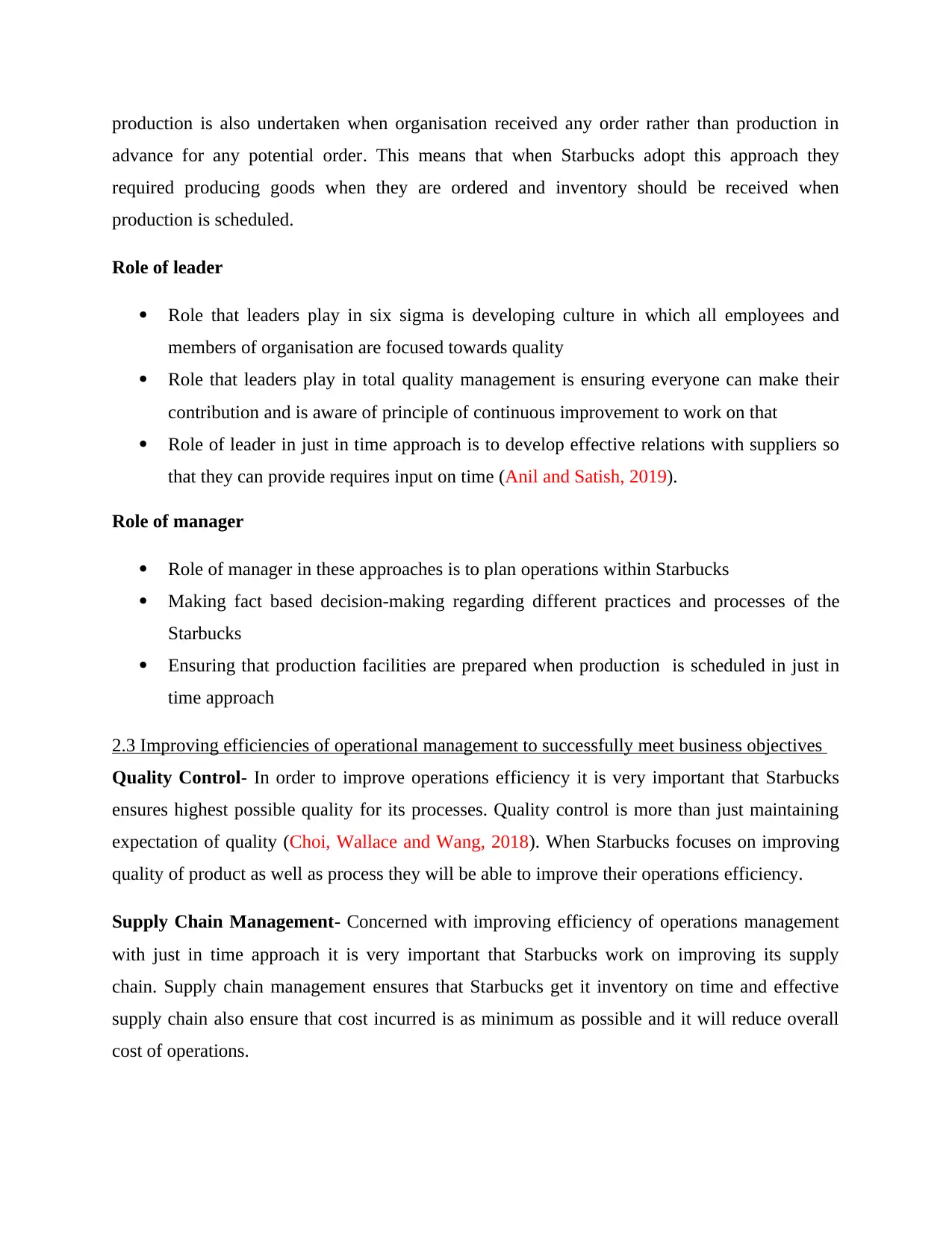
production is also undertaken when organisation received any order rather than production in
advance for any potential order. This means that when Starbucks adopt this approach they
required producing goods when they are ordered and inventory should be received when
production is scheduled.
Role of leader
Role that leaders play in six sigma is developing culture in which all employees and
members of organisation are focused towards quality
Role that leaders play in total quality management is ensuring everyone can make their
contribution and is aware of principle of continuous improvement to work on that
Role of leader in just in time approach is to develop effective relations with suppliers so
that they can provide requires input on time (Anil and Satish, 2019).
Role of manager
Role of manager in these approaches is to plan operations within Starbucks
Making fact based decision-making regarding different practices and processes of the
Starbucks
Ensuring that production facilities are prepared when production is scheduled in just in
time approach
2.3 Improving efficiencies of operational management to successfully meet business objectives
Quality Control- In order to improve operations efficiency it is very important that Starbucks
ensures highest possible quality for its processes. Quality control is more than just maintaining
expectation of quality (Choi, Wallace and Wang, 2018). When Starbucks focuses on improving
quality of product as well as process they will be able to improve their operations efficiency.
Supply Chain Management- Concerned with improving efficiency of operations management
with just in time approach it is very important that Starbucks work on improving its supply
chain. Supply chain management ensures that Starbucks get it inventory on time and effective
supply chain also ensure that cost incurred is as minimum as possible and it will reduce overall
cost of operations.
advance for any potential order. This means that when Starbucks adopt this approach they
required producing goods when they are ordered and inventory should be received when
production is scheduled.
Role of leader
Role that leaders play in six sigma is developing culture in which all employees and
members of organisation are focused towards quality
Role that leaders play in total quality management is ensuring everyone can make their
contribution and is aware of principle of continuous improvement to work on that
Role of leader in just in time approach is to develop effective relations with suppliers so
that they can provide requires input on time (Anil and Satish, 2019).
Role of manager
Role of manager in these approaches is to plan operations within Starbucks
Making fact based decision-making regarding different practices and processes of the
Starbucks
Ensuring that production facilities are prepared when production is scheduled in just in
time approach
2.3 Improving efficiencies of operational management to successfully meet business objectives
Quality Control- In order to improve operations efficiency it is very important that Starbucks
ensures highest possible quality for its processes. Quality control is more than just maintaining
expectation of quality (Choi, Wallace and Wang, 2018). When Starbucks focuses on improving
quality of product as well as process they will be able to improve their operations efficiency.
Supply Chain Management- Concerned with improving efficiency of operations management
with just in time approach it is very important that Starbucks work on improving its supply
chain. Supply chain management ensures that Starbucks get it inventory on time and effective
supply chain also ensure that cost incurred is as minimum as possible and it will reduce overall
cost of operations.
⊘ This is a preview!⊘
Do you want full access?
Subscribe today to unlock all pages.

Trusted by 1+ million students worldwide
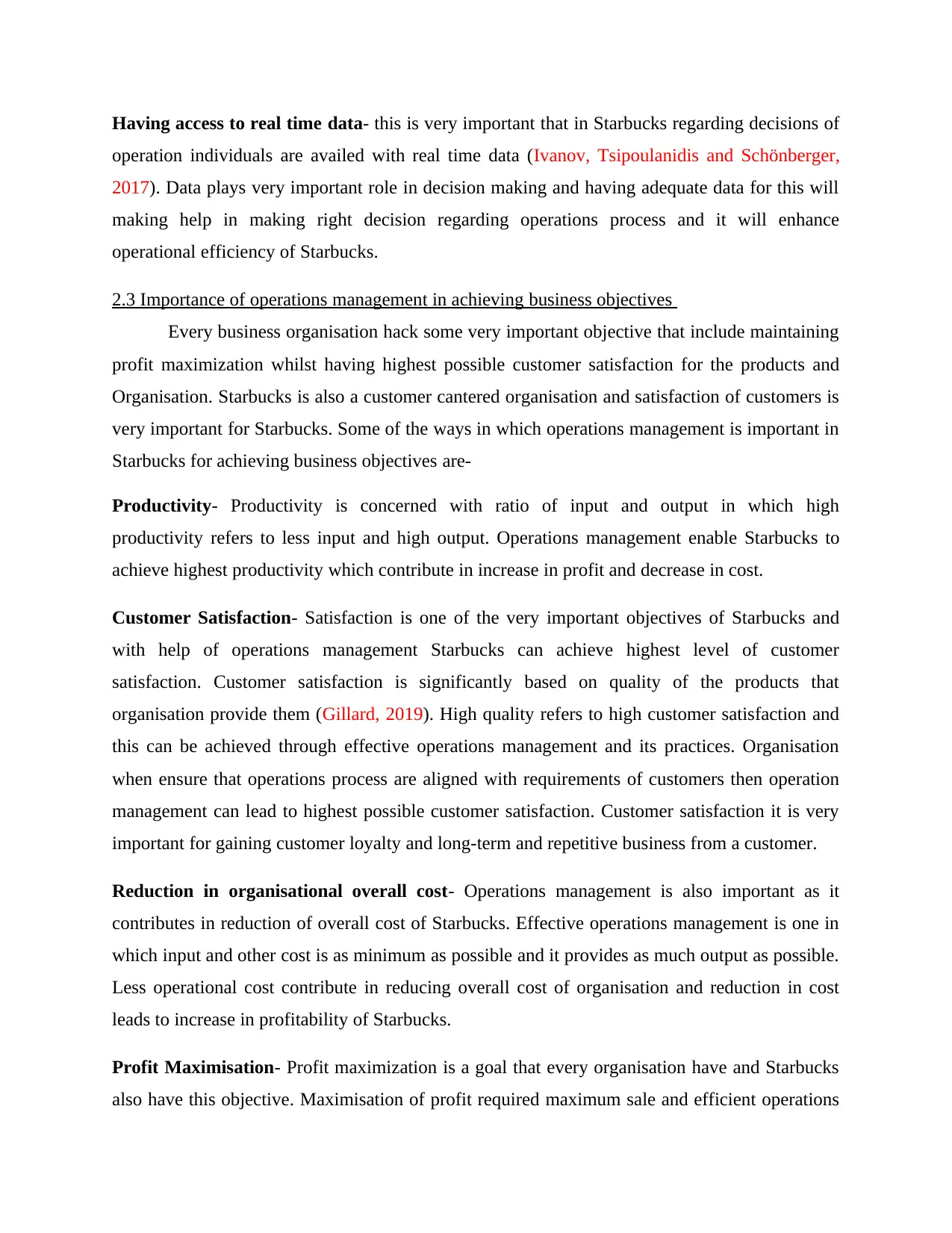
Having access to real time data- this is very important that in Starbucks regarding decisions of
operation individuals are availed with real time data (Ivanov, Tsipoulanidis and Schönberger,
2017). Data plays very important role in decision making and having adequate data for this will
making help in making right decision regarding operations process and it will enhance
operational efficiency of Starbucks.
2.3 Importance of operations management in achieving business objectives
Every business organisation hack some very important objective that include maintaining
profit maximization whilst having highest possible customer satisfaction for the products and
Organisation. Starbucks is also a customer cantered organisation and satisfaction of customers is
very important for Starbucks. Some of the ways in which operations management is important in
Starbucks for achieving business objectives are-
Productivity- Productivity is concerned with ratio of input and output in which high
productivity refers to less input and high output. Operations management enable Starbucks to
achieve highest productivity which contribute in increase in profit and decrease in cost.
Customer Satisfaction- Satisfaction is one of the very important objectives of Starbucks and
with help of operations management Starbucks can achieve highest level of customer
satisfaction. Customer satisfaction is significantly based on quality of the products that
organisation provide them (Gillard, 2019). High quality refers to high customer satisfaction and
this can be achieved through effective operations management and its practices. Organisation
when ensure that operations process are aligned with requirements of customers then operation
management can lead to highest possible customer satisfaction. Customer satisfaction it is very
important for gaining customer loyalty and long-term and repetitive business from a customer.
Reduction in organisational overall cost- Operations management is also important as it
contributes in reduction of overall cost of Starbucks. Effective operations management is one in
which input and other cost is as minimum as possible and it provides as much output as possible.
Less operational cost contribute in reducing overall cost of organisation and reduction in cost
leads to increase in profitability of Starbucks.
Profit Maximisation- Profit maximization is a goal that every organisation have and Starbucks
also have this objective. Maximisation of profit required maximum sale and efficient operations
operation individuals are availed with real time data (Ivanov, Tsipoulanidis and Schönberger,
2017). Data plays very important role in decision making and having adequate data for this will
making help in making right decision regarding operations process and it will enhance
operational efficiency of Starbucks.
2.3 Importance of operations management in achieving business objectives
Every business organisation hack some very important objective that include maintaining
profit maximization whilst having highest possible customer satisfaction for the products and
Organisation. Starbucks is also a customer cantered organisation and satisfaction of customers is
very important for Starbucks. Some of the ways in which operations management is important in
Starbucks for achieving business objectives are-
Productivity- Productivity is concerned with ratio of input and output in which high
productivity refers to less input and high output. Operations management enable Starbucks to
achieve highest productivity which contribute in increase in profit and decrease in cost.
Customer Satisfaction- Satisfaction is one of the very important objectives of Starbucks and
with help of operations management Starbucks can achieve highest level of customer
satisfaction. Customer satisfaction is significantly based on quality of the products that
organisation provide them (Gillard, 2019). High quality refers to high customer satisfaction and
this can be achieved through effective operations management and its practices. Organisation
when ensure that operations process are aligned with requirements of customers then operation
management can lead to highest possible customer satisfaction. Customer satisfaction it is very
important for gaining customer loyalty and long-term and repetitive business from a customer.
Reduction in organisational overall cost- Operations management is also important as it
contributes in reduction of overall cost of Starbucks. Effective operations management is one in
which input and other cost is as minimum as possible and it provides as much output as possible.
Less operational cost contribute in reducing overall cost of organisation and reduction in cost
leads to increase in profitability of Starbucks.
Profit Maximisation- Profit maximization is a goal that every organisation have and Starbucks
also have this objective. Maximisation of profit required maximum sale and efficient operations
Paraphrase This Document
Need a fresh take? Get an instant paraphrase of this document with our AI Paraphraser
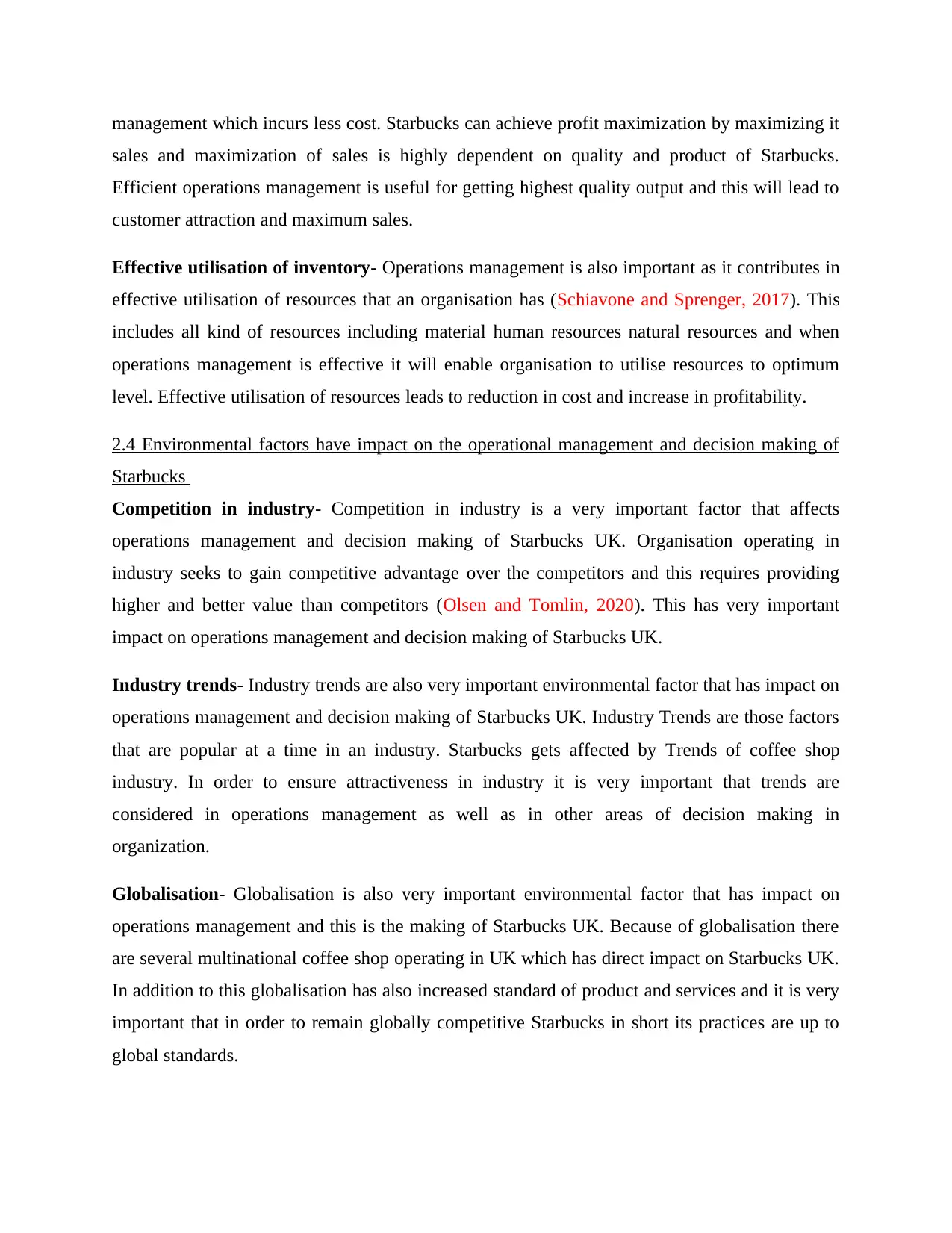
management which incurs less cost. Starbucks can achieve profit maximization by maximizing it
sales and maximization of sales is highly dependent on quality and product of Starbucks.
Efficient operations management is useful for getting highest quality output and this will lead to
customer attraction and maximum sales.
Effective utilisation of inventory- Operations management is also important as it contributes in
effective utilisation of resources that an organisation has (Schiavone and Sprenger, 2017). This
includes all kind of resources including material human resources natural resources and when
operations management is effective it will enable organisation to utilise resources to optimum
level. Effective utilisation of resources leads to reduction in cost and increase in profitability.
2.4 Environmental factors have impact on the operational management and decision making of
Starbucks
Competition in industry- Competition in industry is a very important factor that affects
operations management and decision making of Starbucks UK. Organisation operating in
industry seeks to gain competitive advantage over the competitors and this requires providing
higher and better value than competitors (Olsen and Tomlin, 2020). This has very important
impact on operations management and decision making of Starbucks UK.
Industry trends- Industry trends are also very important environmental factor that has impact on
operations management and decision making of Starbucks UK. Industry Trends are those factors
that are popular at a time in an industry. Starbucks gets affected by Trends of coffee shop
industry. In order to ensure attractiveness in industry it is very important that trends are
considered in operations management as well as in other areas of decision making in
organization.
Globalisation- Globalisation is also very important environmental factor that has impact on
operations management and this is the making of Starbucks UK. Because of globalisation there
are several multinational coffee shop operating in UK which has direct impact on Starbucks UK.
In addition to this globalisation has also increased standard of product and services and it is very
important that in order to remain globally competitive Starbucks in short its practices are up to
global standards.
sales and maximization of sales is highly dependent on quality and product of Starbucks.
Efficient operations management is useful for getting highest quality output and this will lead to
customer attraction and maximum sales.
Effective utilisation of inventory- Operations management is also important as it contributes in
effective utilisation of resources that an organisation has (Schiavone and Sprenger, 2017). This
includes all kind of resources including material human resources natural resources and when
operations management is effective it will enable organisation to utilise resources to optimum
level. Effective utilisation of resources leads to reduction in cost and increase in profitability.
2.4 Environmental factors have impact on the operational management and decision making of
Starbucks
Competition in industry- Competition in industry is a very important factor that affects
operations management and decision making of Starbucks UK. Organisation operating in
industry seeks to gain competitive advantage over the competitors and this requires providing
higher and better value than competitors (Olsen and Tomlin, 2020). This has very important
impact on operations management and decision making of Starbucks UK.
Industry trends- Industry trends are also very important environmental factor that has impact on
operations management and decision making of Starbucks UK. Industry Trends are those factors
that are popular at a time in an industry. Starbucks gets affected by Trends of coffee shop
industry. In order to ensure attractiveness in industry it is very important that trends are
considered in operations management as well as in other areas of decision making in
organization.
Globalisation- Globalisation is also very important environmental factor that has impact on
operations management and this is the making of Starbucks UK. Because of globalisation there
are several multinational coffee shop operating in UK which has direct impact on Starbucks UK.
In addition to this globalisation has also increased standard of product and services and it is very
important that in order to remain globally competitive Starbucks in short its practices are up to
global standards.
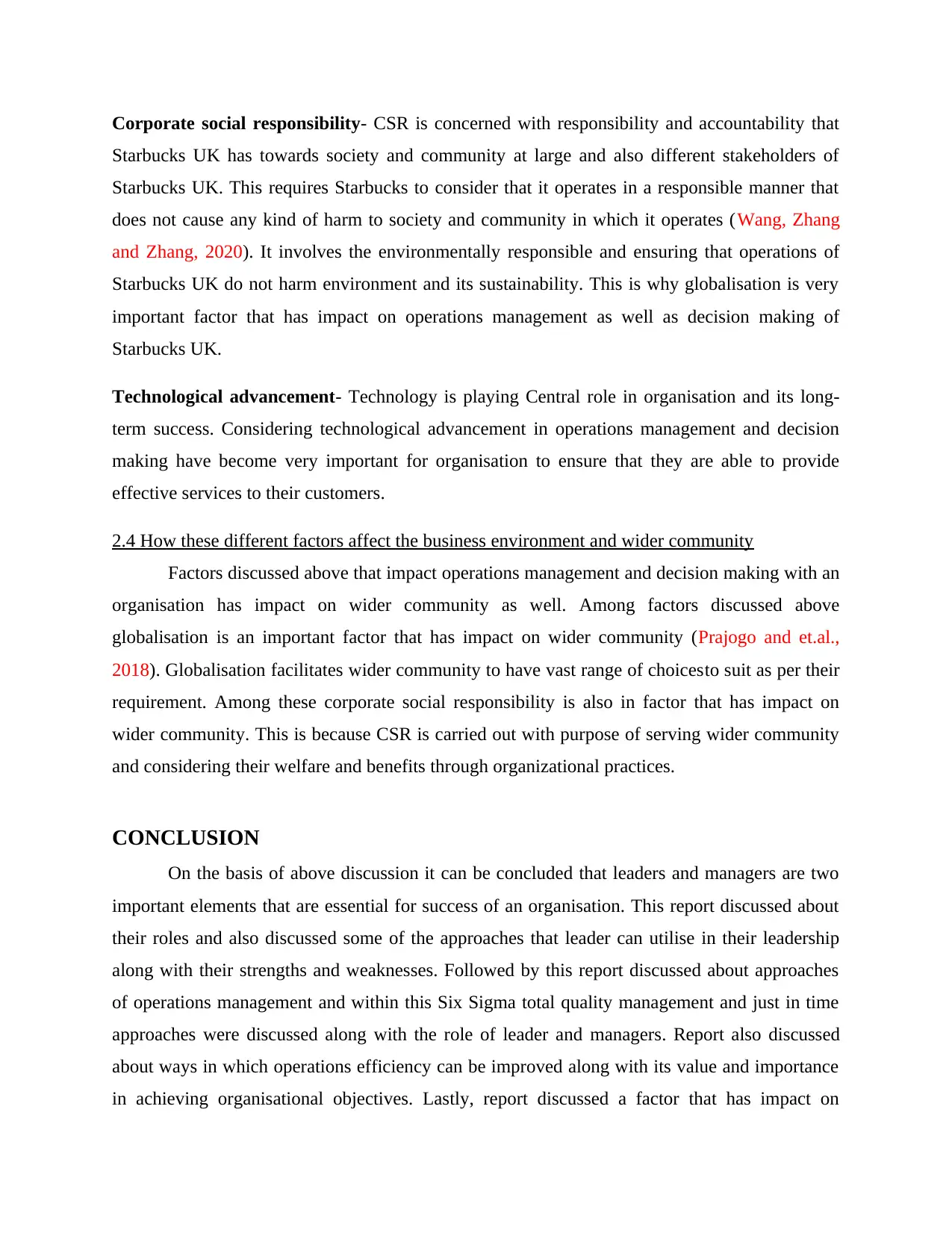
Corporate social responsibility- CSR is concerned with responsibility and accountability that
Starbucks UK has towards society and community at large and also different stakeholders of
Starbucks UK. This requires Starbucks to consider that it operates in a responsible manner that
does not cause any kind of harm to society and community in which it operates (Wang, Zhang
and Zhang, 2020). It involves the environmentally responsible and ensuring that operations of
Starbucks UK do not harm environment and its sustainability. This is why globalisation is very
important factor that has impact on operations management as well as decision making of
Starbucks UK.
Technological advancement- Technology is playing Central role in organisation and its long-
term success. Considering technological advancement in operations management and decision
making have become very important for organisation to ensure that they are able to provide
effective services to their customers.
2.4 How these different factors affect the business environment and wider community
Factors discussed above that impact operations management and decision making with an
organisation has impact on wider community as well. Among factors discussed above
globalisation is an important factor that has impact on wider community (Prajogo and et.al.,
2018). Globalisation facilitates wider community to have vast range of choicesto suit as per their
requirement. Among these corporate social responsibility is also in factor that has impact on
wider community. This is because CSR is carried out with purpose of serving wider community
and considering their welfare and benefits through organizational practices.
CONCLUSION
On the basis of above discussion it can be concluded that leaders and managers are two
important elements that are essential for success of an organisation. This report discussed about
their roles and also discussed some of the approaches that leader can utilise in their leadership
along with their strengths and weaknesses. Followed by this report discussed about approaches
of operations management and within this Six Sigma total quality management and just in time
approaches were discussed along with the role of leader and managers. Report also discussed
about ways in which operations efficiency can be improved along with its value and importance
in achieving organisational objectives. Lastly, report discussed a factor that has impact on
Starbucks UK has towards society and community at large and also different stakeholders of
Starbucks UK. This requires Starbucks to consider that it operates in a responsible manner that
does not cause any kind of harm to society and community in which it operates (Wang, Zhang
and Zhang, 2020). It involves the environmentally responsible and ensuring that operations of
Starbucks UK do not harm environment and its sustainability. This is why globalisation is very
important factor that has impact on operations management as well as decision making of
Starbucks UK.
Technological advancement- Technology is playing Central role in organisation and its long-
term success. Considering technological advancement in operations management and decision
making have become very important for organisation to ensure that they are able to provide
effective services to their customers.
2.4 How these different factors affect the business environment and wider community
Factors discussed above that impact operations management and decision making with an
organisation has impact on wider community as well. Among factors discussed above
globalisation is an important factor that has impact on wider community (Prajogo and et.al.,
2018). Globalisation facilitates wider community to have vast range of choicesto suit as per their
requirement. Among these corporate social responsibility is also in factor that has impact on
wider community. This is because CSR is carried out with purpose of serving wider community
and considering their welfare and benefits through organizational practices.
CONCLUSION
On the basis of above discussion it can be concluded that leaders and managers are two
important elements that are essential for success of an organisation. This report discussed about
their roles and also discussed some of the approaches that leader can utilise in their leadership
along with their strengths and weaknesses. Followed by this report discussed about approaches
of operations management and within this Six Sigma total quality management and just in time
approaches were discussed along with the role of leader and managers. Report also discussed
about ways in which operations efficiency can be improved along with its value and importance
in achieving organisational objectives. Lastly, report discussed a factor that has impact on
⊘ This is a preview!⊘
Do you want full access?
Subscribe today to unlock all pages.

Trusted by 1+ million students worldwide
1 out of 15
Related Documents
Your All-in-One AI-Powered Toolkit for Academic Success.
+13062052269
info@desklib.com
Available 24*7 on WhatsApp / Email
![[object Object]](/_next/static/media/star-bottom.7253800d.svg)
Unlock your academic potential
Copyright © 2020–2025 A2Z Services. All Rights Reserved. Developed and managed by ZUCOL.





